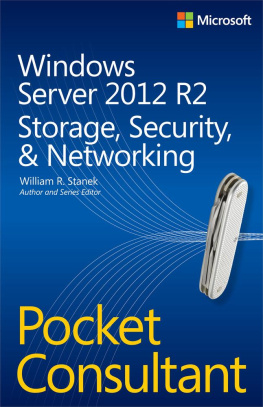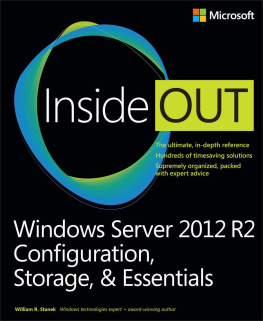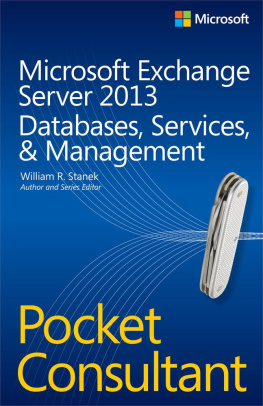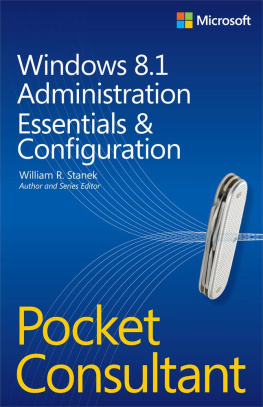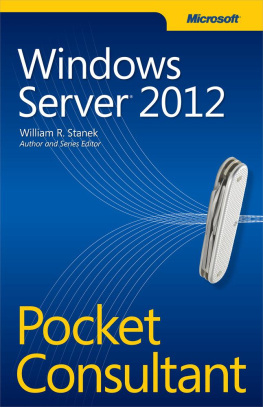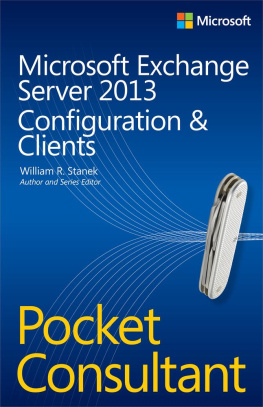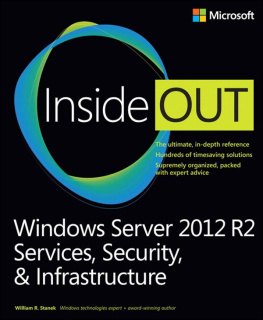Windows Server 2012 R2 Pocket Consultant: Storage, Security, & Networking
William R. Stanek
Published by Microsoft Press
Acknowledgments
To my readersthank you for being there with me through many books and many years. It has been an honor and a privilege to be your pocket consultant.
To my wifefor many years, through many books, many millions of words, and many thousands of pages shes been there, providing support and encouragement and making every place weve lived a home.
To my kidsfor helping me see the world in new ways, for having exceptional patience and boundless love, and for making every day an adventure.
To Anne, Karen, Martin, Lucinda, Juliana, and many others whove helped out in ways both large and small.
Special thanks to my son Will for not only installing and managing my extensive dev lab for all my books since Windows 8 Pocket Consultant but for also performing check reads of all those books as well.
William R. Stanek
Introduction
Windows Server 2012 R2 Pocket Consultant: Storage, Security, & Networking is designed to be a concise and compulsively usable resource for Windows administrators, developers, and programmers, and for anyone else who wants to use the storage, networking, and security features of Windows Server 2012 R2. This is the readable resource guide that youll want on your desk or in your pocket at all times. The book discusses everything you need to perform core tasks. Because the focus is directed on providing you with the maximum value in a pocket-sized guide, you dont have to wade through hundreds of pages of extraneous information to find what youre looking for. Instead, youll find exactly what you need to get the job done.
In short, the book is designed to be the one resource you consult whenever you have questions regarding storage, networking, and security in Windows Server 2012 R2. To this end, the book concentrates on configuration options, frequently used tasks, documented examples, and options that are representative but not necessarily inclusive. One of the goals is to keep the content so concise that the book remains compact and easy to navigate while ensuring that the book is packed with as much information as possiblemaking it a valuable resource.
Anyone transitioning to Windows Server 2012 R2 from Windows Server 2012 might be surprised at just how much has been updated, as changes both subtle and substantial have been made throughout the operating system. Like Windows Server 2012, Windows Server 2012 R2 supports a touch user interface (UI), in addition to the traditional mouse and keyboard.
Although you might not install Windows Server 2012 R2 on touch UIcapable computers, you can manage Windows Server 2012 R2 from your touch UIcapable computers. If you do end up managing it this way, understanding the touch UI in addition to the revised interface options will be crucial to your success. For this reason, I discuss both the touch UI and the traditional mouse and keyboard techniques throughout this book.
When you are working with touch-enabled computers, you can manipulate on-screen elements in ways that werent possible previously. You can do any of the following:
Tap . Tap an item by touching it with your finger. A tap or double-tap of elements on the screen generally is the equivalent of a mouse click or double-click.
Press and hold . Press your finger down and leave it there for a few seconds. Pressing and holding elements on the screen generally is the equivalent of a right-click.
Swipe to select . Slide an item a short distance in the opposite direction compared to how the page scrolls. This selects the items and might also bring up related commands. If press and hold doesnt display commands and options for an item, try using swipe to select instead.
Swipe from edge (slide in from edge) . Starting from the edge of the screen, swipe or slide in. Sliding in from the right edge opens the Charms panel. Sliding in from the left edge shows open apps and enables you to switch between them easily. Sliding in from the top or bottom edge shows commands for the active element.
Pinch . Touch an item with two or more fingers, and then move the fingers toward each other. Pinching zooms out.
Stretch . Touch an item with two or more fingers, and then move the fingers away from each other. Stretching zooms in.
You are also able to enter text using the on-screen keyboard. Although the UI changes are substantial, they arent the most significant changes to the operating system. The most significant changes are below the surface, affecting the underlying architecture and providing many new features. Some of these features are revolutionary in that they forever change the way we use Windows.
As youve probably noticed, a great deal of information about Windows Server 2012 R2 is available on the Web and in other printed books. You can find tutorials, reference sites, discussion groups, and more to make using Windows Server 2012 R2 easier. However, the advantage of reading this book is that much of the information you need to learn about Windows Server 2012 R2 is organized in one place and presented in a straightforward and orderly fashion. This book has everything you need to customize Windows Server 2012 R2 installations, master Windows Server 2012 R2 configurations, and maintain Windows Server 2012 R2 servers.
In this book, I teach you how features work, why they work the way they do, and how to customize them to meet your needs. I also offer specific examples of how certain features can meet your needs, and how you can use other features to troubleshoot and resolve issues you might have. In addition, this book provides tips, best practices, and examples of how to optimize Windows Server 2012 R2. This book wont just teach you how to configure Windows Server 2012 R2, it will teach you how to squeeze every last bit of power out of it and make the most from the features and options it includes.
Unlike many other books about managing Windows Server 2012 R2, this book doesnt focus on a specific user level. This isnt a lightweight beginner book. Regardless of whether you are a beginning administrator or a seasoned professional, many of the concepts in this book will be valuable to you, and you can apply them to your Windows Server 2012 R2 installations.
Who is this book for?
Windows Server 2012 R2 Pocket Consultant: Storage, Security, & Networking covers all editions of Windows Server 2012 R2. The book is designed for the following readers:
Current Windows system administrators
Accomplished users who have some administrator responsibilities
Administrators upgrading to Windows Server 2012 R2 from previous versions
Administrators transferring from other platforms
To pack in as much information as possible, I had to assume that you have basic networking skills and a basic understanding of Windows Server. With this in mind, I dont devote entire chapters to explaining Windows Server architecture or why you want to use Windows Server. I do, however, cover configuring storage, security, auditing, and much more.
I also assume that you are fairly familiar with Windows commands and procedures in addition to the Windows user interface. If you need help learning Windows basics, you should read other resources (many of which are available from Microsoft Press).
How is this book organized?

